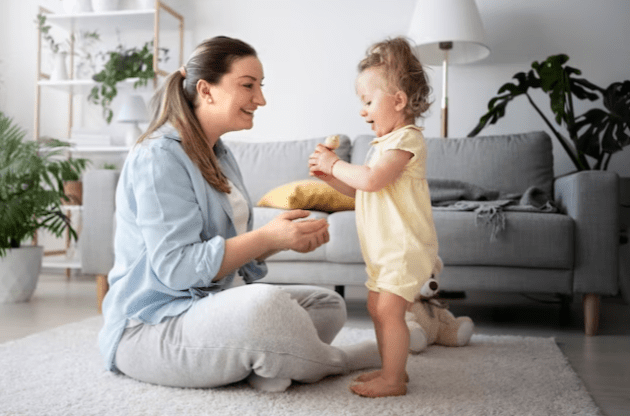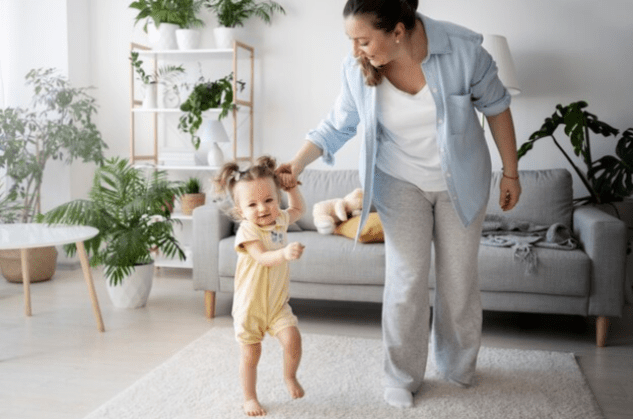Before you know it, your baby will become a lot more mobile—rolling, scooting, crawling, or even pulling themselves up to stand. And they’ll also get much better at grabbing, holding, and moving things around. That means it’s time to do some child- and babyproofing in your home to keep your little one safe. Here are some tips on how to babyproof your house, including ideas for different rooms and a simple babyproof living checklist to help keep you on track.
What Is Babyproofing?
Having small children or a baby at home can be bundles of fun. However, once your little one is on the move, you may discover more safety issues than you knew existed. Though many risks and hazards in your home may be easy for adults to navigate, your little adventurer won’t be able to recognize these things as dangers, whether it’s a hot stove, sharp objects, or unstable furniture. So, identifying possible safety hazards and creating a safe environment for your child is the key to successfully babyproofing and childproofing your home.
When to Babyproof Living

From day one it’s important to always have a set of eyes on your baby to ensure they are safe and happy. Each step of your little one’s infancy, toddlerhood, and childhood brings its own challenges—or adventures! So, it’s good to be aware of any baby- or childproofing measures to take during each stage.
Are you wondering at what age (of your baby) you should begin to childproof your home? Some parents get started during pregnancy, while others wait until their baby is born. It’s wise to begin the process on the early side rather than putting it off. Once your little one starts to crawl and move about by themselves, you need to take extra steps to deal with dangerous objects and hazardous locations—because to them the whole house looks like a playground!
Prepare yourself by babyproofing your house before your baby is on the move. A good plan is to get down to your baby’s level (that’s right—crawl around on the floor!) to see what your baby sees and what could pose a hazard. And as your little one gets older and more active, try to anticipate where their curiosity and reach may take them.
Even if you’re not starting from scratch at home, you can still ensure your home is babyproofed. Simply take a few days to look over your own space and make sure each room is safe from potential hazards as your baby starts crawling, walking, or starting to climb. Here’s how to tackle babyproofing room-by-room.
Tackle the Big Things First
If there are some big babyproofing projects or repairs you’ve been putting off, now’s the time to tackle them. Replace that broken window, fix the leaking hot-water heater (it should be set below 120 degrees F to avoid a scalding hot bath for the baby), and check your smoke and carbon monoxide detectors. If your house was built before 1978, it’s also important to determine if you have lead paint on the interior windowsills, door frames, and other areas, says Kelly Johnson-Arbor, M.D., medical toxicologist and co-medical director of the National Capital Poison Center.
“In an older home, peeling or chipping paint surfaces may represent a source of lead exposure, especially for young children and toddlers who are crawling around or touching those surfaces,” says Dr. Johnson-Arbor. “Never attempt to perform your own renovation or repair of lead-based surfaces; always use a lead-safe contractor (the EPA website is a helpful resource for this).”
Also, look at your existing furniture to consider what pieces should be mounted to the wall to avoid tipping. If you’re in the market for new furniture pieces, you don’t have to sacrifice style for safety, explains Alessandra Wood, vice president of style at Modsy, but you should look for items that come with anti-tip kits, have higher safety standards, rounder corners, and fewer chemicals used in production.
“My mom always said to me: You can have nice things when you have children, you just have to teach your children to have respect for them,” says Wood. “We think children will be destructive little people, but we can teach them how to respect the things around us.” That said, toddlers are going to grab at and hold on to anything within reach when learning to walk—and also might walk or fall into anything that’s in their path. So, it’s important to consider what potential dangers they could encounter.
Assess the Kitchen
Consider which potential hazards your child may be able to access in your kitchen. If your home layout is anything like mine, you likely have an open-concept kitchen. This means even if you are in the living room, your mobile baby can easily find a way to the cabinets or pantry and your typical doorway gate won’t be an option.
No need to panic, but it’s a good idea to invest in modern childproof cabinet locks. The former owners of my apartment used stick-on plastic latch locks that all but damaged the wood on the cabinet doors. Needless to say, we had to rip them out and start from scratch. Avoid that mess by looking for magnetic locks that can be mounted on the inside of cabinets while offering the same safety features and easy adult access. Also, put away any dangerous items like knives and consider stove-knob covers to prevent your baby from turning on the burners once they’re standing.
While it might be common to keep cleaning supplies under the kitchen sink, Dr. Johnson-Arbor suggests finding a new place for them that is high up and out of reach. “This is especially true [since] the COVID-19 pandemic, as many people are keeping cleaning supplies close at hand; we may also be using cleaning products that we have not used frequently in the past,” she says.
“Some cleaning products have colorful labeling which may appeal to young children; disinfecting solutions may feature citrus scents or similar fragrances, and young children may not know that products that smell good may also be poisonous. Always keep these containers well hidden from young children, in an area where they cannot reach by climbing or crawling,” suggests Dr. Johnson-Arbor.
She also reminds parents to avoid transferring cleaning products into other containers that aren’t properly labeled, even if it looks more organized or helps save space. “This is potentially quite dangerous as young children and other individuals in the home may not realize what is actually present in the container.”
For safety and convenience Wood suggests avoiding a glass top table since they can be less stable than wood or metal ones and skip styling the room with a rug under the table you most commonly eat at. “In early life stages, you don’t want a rug under the dining room table because of spills or messes,” she says. “That rug is going to need a lot of cleaning and care—if you have hard floors leave them exposed until you have controlled eaters.”
General Tips for Baby Proofing Your Home Before Baby Arrives
- Install working carbon monoxide detectors on every story of your house
- Install smoke detectors on every level of your home and in the hallways outside of bedrooms
- Check the batteries of any detectors you already have
- Purchase a fire extinguisher
- You’ll also want to learn how to use it
- Safely store any firearms.
- Keep them unloaded and locked in a gun safe, and make sure all firearms are equipped with trigger locks
- Never leave any amount of water in an open container or bucket baby could reach
- Stock your medicine cabinet or first-aid kit
- Plus, keep items out of reach
- Add emergency contacts and medical information to your phone
- Do this so that can be accessed even in lock mode. This includes the nationwide Poison Control Center hotline (1-800-222-1222)
- Have at least one landline phone in your home.
- Cordless phones don’t work when the power is out, and cell phone batteries can run out. Place a list of emergency numbers near the landline
- Make sure your home or apartment number is easy to see so fire or rescue can locate you quickly in an emergency
- Install a temperature guard on your water heater at a maximum of 120 degrees Fahrenheit (48 degrees Celsius)
- Get any flaking or peeling paint sealed or removed by a professional, especially if your home was built before 1978.
- Dust from lead paint, which was banned from residential use in that year, can be harmful if ingested
- Never leave small objects like coins and batteries (including button batteries) lying around
General Tips for Baby Proofing Your Home Before Baby’s on the Move

- Secure all furniture to prevent tip-over accidents
- Cover all sharp furniture edges and corners with safety padding (except baby’s crib)
- Put non-slip pads under all rugs
- Move all dangerous items to cupboards and drawers out of baby’s reach
- This includes cleaners, knives, heavy objects, medications, staplers, scissors etc.
- Keep alcoholic beverages, nicotine products, vape pens and pods, edible marijuana products, etc. locked in cabinets and out of reach
- If these are being consumed or used, don’t ever leave them unattended
- Latch closed any cupboards, drawers and doors within baby’s reach to avoid pinched fingers or unsupervised explorations
- Purchase baby-safe door stops for every door to prevent accidental closings
- Put baby gates or fences at the top and bottom of every set of stairs, no matter how short the flight
- Use garden fences or plexiglass to block any space of more than four inches between stair or balcony rails
- Install window guards and stops, and put safety bars or gates on all windows, landings and decks
- Get rid of any blinds or curtains with looped cords, or install safety tassels and cord stops to tuck away the cords
- Hide any and all cords out of sight
- Put safety covers over all electrical outlets
- Always unplug and store electric appliances that aren’t in use
- This includes iron, curling iron, etc.
- Always store any and all purses or bags out of baby’s reach
- Don’t forget to baby proof your own bedroom and closet
Keep any nightstand items, bathroom items (like razors) and closet items (like ties) stored away from baby’s reach with a child safety lock where possible. You may not think of it, but curious tots may try to “shave” or “wear a tie” like they see their parents do.
We hope you found this information helpful in your journey to create a safer environment for your family. At GuardWell Safety, we understand that every home is unique, and so are your child-proofing needs. That’s why we offer a Free Child-Proofing Consultation tailored to your specific requirements. Let our experts help you identify potential hazards and provide personalized solutions to make your home a secure haven for your little ones. Book your free consultation today and take the first step towards peace of mind.






